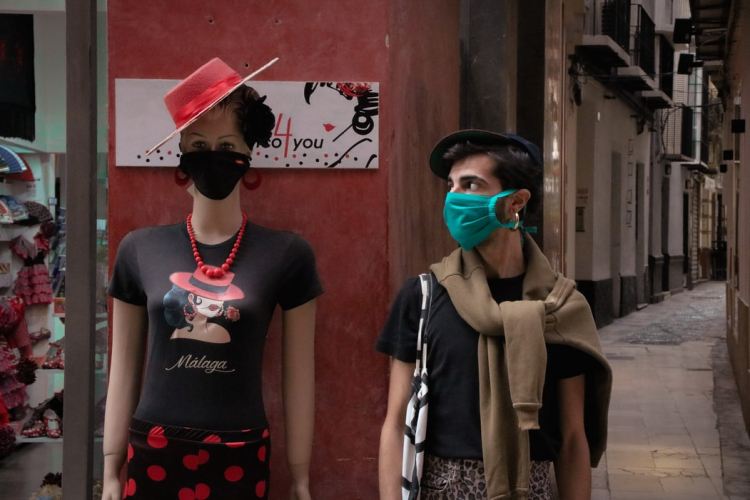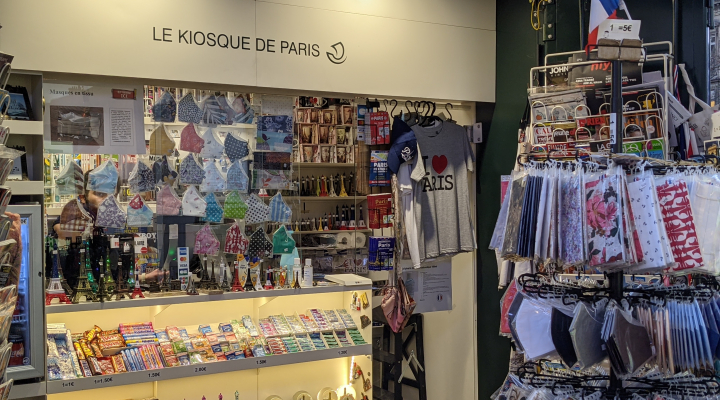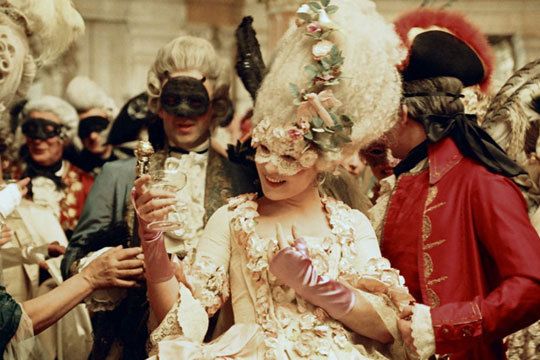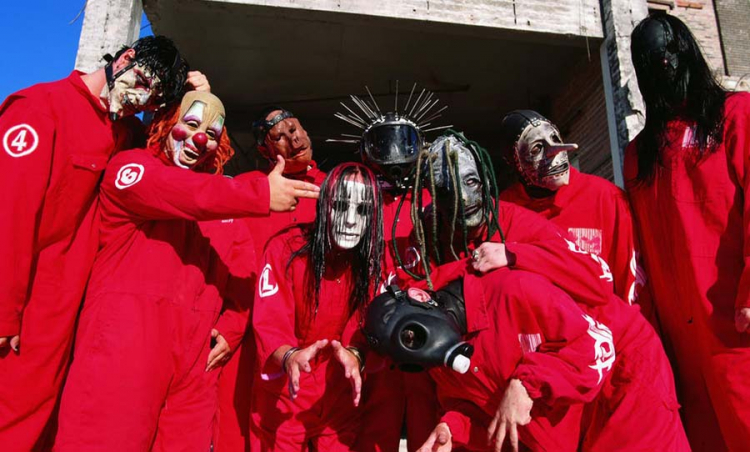How the Pandemic Created a Mask Culture

At the Paris newsstand next to Hôtel de Ville, a revolving display offers a wide variety of colorful masks. Most are made from brightly colored fabrics and patterned textiles in different styles, thickness, and shapes.
Women of all ages are pressed against the display, defying mandatory social distancing rules in their consumer quest for a mask that suits their personal taste. The man behind the newsstand counter observes his mask-buying customers with an air of satisfaction. For some merchants, there is a commercial upside to this pandemic.
“We make okay money selling masks during the confinement,” says Akim, the Hôtel de Ville newsstand operator. Akim is from Algeria and has been working at the kiosk for seven years. In his early thirties, he's keen on practicing his English when interviewed. “Please, in English,” he responds when initially asked questions in French. Within five minutes, at least eight mask purchases have been made.
Akim watches one twentysomething woman as she puts on her newly purchased mask — a solid peach color that matches her green floral-print dress — before heading back into the streets of Paris. Parisians looking for something more upscale than standard soft blue surgical masks can stop at places like this kiosk to find a stylish and serviceable mask for about five euros a piece.
The global pandemic has changed many aspects of our lives — and one of them is how we look in public. In France, mask-wearing is mandatory outdoors, with exceptions made for joggers and cyclists. There has been some grumbling amongst the French, but compliance has been widespread. This contrasts with reactions in the United States, where pandemic rules have provoked an uproar amongst people who claim mandatory masks are an infringement of their individual freedom. For those armed with more scientific knowledge, it is accepted that masks stop COVID-19 particles being exhaled and potentially infecting others. Cloth masks are now accepted as an alternative to surgical or N95 masks.
Many now regard masks as an extension of their fashion sense. Hence the exploding market demand for masks that are more than standard blue or white. “I have a bunch of tie-dye masks and others from small businesses, I get them because I like my masks to work with my outfit,” says Sarah Affonso, an AUP freshman from Mumbai who owns multiple reusable cloth masks. On this day, she is wearing a blue floral print mask to go with her blue sweater and jeans. “I started to wear these handmade reusable masks because I was afraid to create an unnecessary amount of waste and it helps the businesses in my community. Normally, I would like to wear make-up during my first year at university, but I don’t bother [since I’m wearing] the mask. It saves me a lot of time getting ready in the morning, so I am happy.”
Parisian news kiosk seeling masks. Image credit: Ian Hoffman
Masks as sartorial and symbolic accessories have a long history. The earliest known masks were used by ancient peoples for spiritual ceremonies. For instance, ancient tribes in Africa wore masks that resembled the faces of certain animals and incorporated them into their tribal rituals. Later, during the Renaissance, masks were worn fashionably by aristocrats in Europe, where masquerade balls were popular with the upper classes. The idea of hiding one’s identity made these parties more alluring. It gave people of royal descent the opportunity to mingle amongst wealthy socialites without being noticed as well. Even after the renaissance masquerade parties would be thrown in prominent manors in Europe. At these gatherings in the 19th century people would wear masks to hide their identities. One American columnist wrote “society is a masked ball where everyone hides his real character and reveals it by hiding.”
But masks throughout human history has not been limited to tribal rituals nor parties for the affluent. In the music industry masks have been used as a way for artists to express themselves and enhance their music. For instance, Slipknot have utilized masks in their performances since their band started in the late 1990s. Every member of the band has a specific mask that they wear as a part of their character on stage, in their videos and in a lot of interviews. In an interview for the BBC lead vocalist of Slipknot, Corey Taylor said, “the mask for me has always been that physical representation of the person inside that has never had a voice, it allows me to be me.” It could be argued that fans recognize their masks more than they recognize the actual members of the band because of how often they have worn their masks in front of the cameras over the years. Slipknot is not the only musical act to wear masks either. Eminem wore a hockey mask and incorporated a chainsaw as a prop during his Anger Management tour, although this was a onetime deal and he hasn’t worn a mask to perform since. Like Slipknot, French artists Daft Punk have incorporated masks into their performances consistently since their formation. The list of musicians that wear masks is a very long one to say the least.
Marie Antoinette at masquerade in the film "Marie Antoinette". Image credit: Columbia Pictures
Masks have also been used to combat every pandemic since the bubonic plague when doctors wore beaks filled with herbs and spices to ward off what they called “bad air,”, and used sticks to eliminate touch when examining patients. During the influenza pandemic after the First World War, masks were made mandatory in different regions including California. A century alter, they are being relied on once again to fight another flu pandemic. But this time they are being worn differently. In France, the "Gilets Jaunes" protestors wore masks to conceal their identities and spare their lungs from tear gas, which is why the French government banned masks and enforced the ruling with jail time or a 15,000-euro fine.
Our culture is not strictly utilitarian, so we often blend functionality with beauty. This latest concoction is a mask that protects us while being aesthetically pleasing. It makes a lot of money too. Small vendors and high fashion brands alike are selling masks that transcend the basic purpose of the mask. Burberry sells masks with their famous brown plaid and Monoprix has solid-colored ones wrapped in branded plastic. It is a buyer’s market; the people obviously have a yearning for masks that they think suits them. Billie Eillish was even photographed wearing a sheer Gucci apparatus. She is just one of many celebrities who have been seen wearing masks that suit their own personal taste.
“Everyone sort of diversified into masks, whether it’s your big main high fashion brands like Chanel, they have masks as well, but even streetwear like Off-White,” says AUP student Sarah Afonso. “People generally invest in it, especially when it’s hyped.”
Back at the Parisian newsstand in front of Hotel de Ville, kiosk operator Akim says he started selling cloth masks at the beginning of the confinement in March. His masks are manufactured in China, but he insists that all the fabric was produced in France. Asked how many masks he has sold since March; he says the figure is so big that he cannot put a number on it.
“Plus! Plus!” he exclaims as he rubbed his index finger and thumb together in allusion to the profitability of mask sales.
Although, he will not be sad when the pandemic ends and the market for masks dries up, he misses tourism and the opportunity to sell souvenirs and other trinkets. With fewer tourists in Paris due to the pandemic, that market has been hit hard. For the moment, mask sales are helping to keep him afloat.
“I sell to mostly women because of the colors [(of the masks]),” he says. But it is not like all the reusable masks are being worn by women.
The band Slipknot are famous for their masks.
Zach Egan, an AUP junior from New York, has been wearing reusable masks since the beginning of the pandemic. “When they announced mask rules this summer in Paris, I just couldn’t find a store that was selling the single use kinds and I walked by a store next to my house that sold handmade ones, so I bought a few,” he says. “This is going to sound weird, but I bought them from a Thai massage and spa place next to my apartment. Now I wear the Airism ones from Uniqlo.” He paid 3 euros each for the handmade and 4 euros a piece at Uniqlo. Asked if he integrates his masks with his outfit he says “my fashion sense is pretty simple anyway. I like to keep it to basic pieces in neutral colors so having a plain color mask fits with my aesthetic. I don’t like having my mask be a focal point, but rather have blended into my outfit.”
It is becoming more common in France to see most people wearing a reusable mask that fit their style preference. They are widely accessible in clothing stores, newsstands, grocers and online. The revenue from mask sales is clearly helping these businesses as they were hurt economically by the pandemic.
This trend should help the environment as well. As the disposable mask industry is projected to balloon to a 70-billion-dollar industry before 2024, our oceans are being heavily impacted. One-time use masks have been used in such an overwhelming amount that millions of them have drifted out to sea adding to our pollution problem. Reusable masks are the only solution to this side effect of COVID-19. It is a good thing that many people find them so appealing.
The reusable mask is clearly the way to go as the pandemic rages on seemingly without end. In the United States the first doses of the Pfizer vaccine have been distributed to all fifty states, but this does not mean we can stop wearing masks. Dr. Anthony Fauci speculates that Americans will be wearing masks until late fall or early winter of 2021. It is a similar story in central Europe as the vaccine will be slowly distributed, first amongst the immune compromised and elderly, then to everyone else. Top epidemiologists say that this return to normality will be a low and careful process. Until then we will continue utilizing masks and keep our distance from one another.
The Parisian newsstand will continue selling fashionable masks and maybe in 2021 we will see a more dramatic evolution of masks. Popular culture will decide.




